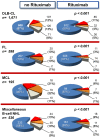Rate of primary refractory disease in B and T-cell non-Hodgkin's lymphoma: correlation with long-term survival
- PMID: 25255081
- PMCID: PMC4177839
- DOI: 10.1371/journal.pone.0106745
Rate of primary refractory disease in B and T-cell non-Hodgkin's lymphoma: correlation with long-term survival
Abstract
Background: Primary refractory disease is a main challenge in the management of non-Hodgkin's Lymphoma (NHL). This survey was performed to define the rate of refractory disease to first-line therapy in B and T-cell NHL subtypes and the long-term survival of primary refractory compared to primary responsive patients.
Methods: Medical records were reviewed of 3,106 patients who had undergone primary treatment for NHL between 1982 and 2012, at the Hematology Centers of Torino and Bergamo, Italy. Primary treatment included CHOP or CHOP-like regimens (63.2%), intensive therapy with autograft (16.9%), or other therapies (19.9%). Among B-cell NHL, 1,356 (47.8%) received first-line chemotherapy with rituximab. Refractory disease was defined as stable/progressive disease, or transient response with disease progression within six months.
Results: Overall, 690 (22.2%) patients showed primary refractory disease, with a higher incidence amongst T-cell compared to B-cell NHL (41.9% vs. 20.5%, respectively, p<0.001). Several other clinico-pathological factors at presentation were variably associated with refractory disease, including histological aggressive disease, unfavorable clinical presentation, Bone Marrow involvement, low lymphocyte/monocyte ration and male gender. Amongst B-cell NHL, the addition of rituximab was associated with a marked reduction of refractory disease (13.6% vs. 26.7% for non-supplemented chemotherapy, p<0.001). Overall, primary responsive patients had a median survival of 19.8 years, compared to 1.3 yr. for refractory patients. A prolonged survival was consistently observed in all primary responsive patients regardless of the histology. The long life expectancy of primary responsive patients was documented in both series managed before and after 2.000. Response to first line therapy resulted by far the most predictive factor for long-term outcome (HR for primary refractory disease: 16.52, p<0.001).
Conclusion: Chemosensitivity to primary treatment is crucial for the long-term survival in NHL. This supports the necessity of studies aimed to early identify refractory disease and to develop different treatment strategies for responsive and refractory patients.
Conflict of interest statement
Figures





References
-
- Armitage JO (2012) The aggressive peripheral T-cell lymphomas: 2012 update on diagnosis, risk stratification, and management. Am J Hematol 87: 511–519. - PubMed
-
- Cabanillas F (2011) Non-Hodgkin’s lymphoma: the old and the new. Clin Lymphoma Myeloma Leuk 11 Suppl 1: S87–90. - PubMed
-
- Moskowitz C (2012) Diffuse large B cell lymphoma: how can we cure more patients in 2012? Best Pract Res Clin Haematol 25: 41–47. - PubMed
Publication types
MeSH terms
Substances
LinkOut - more resources
Full Text Sources
Other Literature Sources
Research Materials

